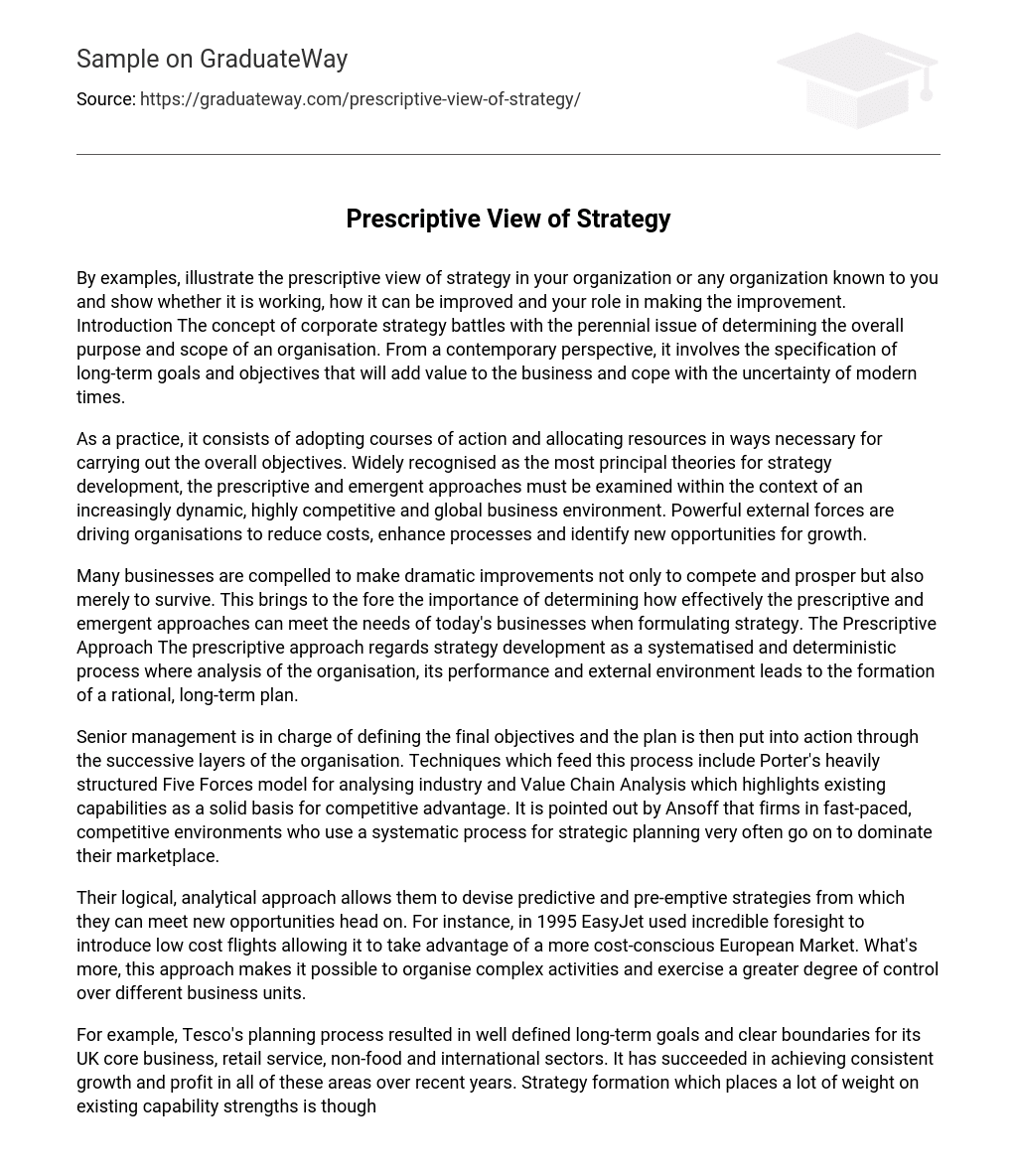By examples, illustrate the prescriptive view of strategy in your organization or any organization known to you and show whether it is working, how it can be improved and your role in making the improvement. Introduction The concept of corporate strategy battles with the perennial issue of determining the overall purpose and scope of an organisation. From a contemporary perspective, it involves the specification of long-term goals and objectives that will add value to the business and cope with the uncertainty of modern times.
As a practice, it consists of adopting courses of action and allocating resources in ways necessary for carrying out the overall objectives. Widely recognised as the most principal theories for strategy development, the prescriptive and emergent approaches must be examined within the context of an increasingly dynamic, highly competitive and global business environment. Powerful external forces are driving organisations to reduce costs, enhance processes and identify new opportunities for growth.
Many businesses are compelled to make dramatic improvements not only to compete and prosper but also merely to survive. This brings to the fore the importance of determining how effectively the prescriptive and emergent approaches can meet the needs of today’s businesses when formulating strategy. The Prescriptive Approach The prescriptive approach regards strategy development as a systematised and deterministic process where analysis of the organisation, its performance and external environment leads to the formation of a rational, long-term plan.
Senior management is in charge of defining the final objectives and the plan is then put into action through the successive layers of the organisation. Techniques which feed this process include Porter’s heavily structured Five Forces model for analysing industry and Value Chain Analysis which highlights existing capabilities as a solid basis for competitive advantage. It is pointed out by Ansoff that firms in fast-paced, competitive environments who use a systematic process for strategic planning very often go on to dominate their marketplace.
Their logical, analytical approach allows them to devise predictive and pre-emptive strategies from which they can meet new opportunities head on. For instance, in 1995 EasyJet used incredible foresight to introduce low cost flights allowing it to take advantage of a more cost-conscious European Market. What’s more, this approach makes it possible to organise complex activities and exercise a greater degree of control over different business units.
For example, Tesco’s planning process resulted in well defined long-term goals and clear boundaries for its UK core business, retail service, non-food and international sectors. It has succeeded in achieving consistent growth and profit in all of these areas over recent years. Strategy formation which places a lot of weight on existing capability strengths is thought to be a secure basis on which a firm should define itself and optimise its position, particularly in times of rapid and turbulent change.
For example, Motorola has successfully met the needs of emerging markets by using its fundamental technological strengths in electronic components to progress from supplying TVs and car radios to offering telecommunications services. From a contrary perspective, Johnson states that the prescriptive model contains many assumptions that are unsustainable in today’s business world. The logical approach implies that strategy development is always deliberate and that strategies are realised according to plan.
However, empirical research by Mintzberg discounts this, highlighting that realised strategy tends to be only 10 to 30 percent of the intended strategy. This is mainly because unpredictable events, such as the introduction of new regulations or technologies, will regularly act to force the original strategy off its course. Additionally, the prescriptive approach to planning falls short in allowing for any learned elements to be absorbed into the strategy and so can limit an organisations ability to respond flexibly in today’s rapidly changing environment.
The narrow-minded manner in which it focuses on established areas of business and capabilities can hinder serious transformational change where reinvention is required. A further criticism is that the prescriptive model fails to complement modern organisational cultures where employees at lower levels are included in the decision making process. This type of involvement is frequently found in small or medium sized businesses. As a result, organisational creativity can be stifled and employee dissonance may occur as it is at these levels that work processes are most fully understood. Conclusion
Within the framework of an environment which is by and large unpredictable, many organisations are forced to become more flexible and adaptive to change. This supports the adoption of an emergent approach to strategy development which invokes a more intelligent capacity to respond to new opportunities. Nonetheless, such a strategy can preclude control over actions and may risk a lack of direction. A greater use of strategic planning tools for internal and external analysis would certainly facilitate improved organisational learning and enhance strategic thinking even while following an emergent approach.
This recognition that the prescriptive and emergent processes, rather than being mutually exclusive, can be complementary approaches that reinforce each other is being highlighted in more recent theories such as the Logical Incrementalism approach proposed by Quinn. All in all, most viable strategies in today’s business world should have customised elements of prescriptive and emergent characteristics in order to manage the complexities of their business and still triumph over changing circumstances.





